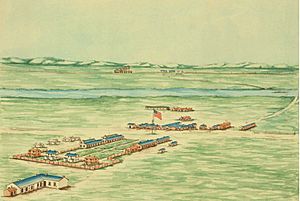Fort Sedgwick facts for kids
Quick facts for kids
Fort Sedgwick
|
|
|---|---|
|
U.S. military post
|
|

Anton Schonborn, Fort Sedgwick, 1870
|
|
| Nickname(s):
Post at Julesburg, Camp Rankin, and Fort Rankin
|
|
| Country | United States |
| State | Colorado |
| County | Sedgwick |
| City | Sedgwick |
Fort Sedgwick was an important United States Army post. It was active from 1864 to 1871. You might also hear it called Post at Julesburg, Camp Rankin, or Fort Rankin. This fort was located in what is now Sedgwick, in Sedgwick County, Colorado. Today, a special marker shows where the old fort used to be. The town of Sedgwick got its name from the fort. The fort itself was named after John Sedgwick. He was a very important general in the Union Army during the American Civil War.
Contents
History of Fort Sedgwick
In 1864, there were more and more conflicts with Native American tribes from the Plains. Because of this, a small military camp was set up near Julesburg. It was first called Camp Rankin and was made of simple sod huts. Later, it was renamed Fort Sedgwick to honor Major General John Sedgwick.
The camp quickly grew into a full military base. By 1866, it had proper buildings for soldiers, stables for horses, and a corral. The soldiers at Fort Sedgwick had an important job. They protected the Overland Stage Route, which was also known as the South Platte Trail. They also guarded the stagecoach stations and the telegraph lines.
Attacks on the Fort and Julesburg
Fort Sedgwick was located about one mile west of Julesburg. It was also south of the South Platte River. Today, the original site of the fort is about 7.5 miles (12.1 km) southwest of the current Julesburg town.
On January 7, 1865, about 1,000 Cheyenne and Sioux warriors attacked Fort Sedgwick and Julesburg. This attack was in response to an event called the Sand Creek massacre, which happened in November 1864. During the attack, some Native Americans and soldiers were killed at the fort. The warriors also took a lot of food and supplies from Julesburg. They took so much that it took three days to move it all to their village.
More attacks happened in 1865 between Julesburg and Fort Morgan. In February, the town of Julesburg was even burned down. However, the town was later rebuilt.
General Custer's Arrival
In June 1867, General William Tecumseh Sherman ordered George Armstrong Custer and six companies of the 7th Cavalry Regiment to Colorado. Their mission was to stop attacks along the South Platte and Smoky Hill Trails. They searched for Native Americans near Fort Sedgwick and on the way to Fort Wallace.
A group of soldiers was also sent to Fort Wallace to get supplies. On their way back, they had to defend themselves against a large force. During this time, 35 soldiers from Custer's group left without permission. They had heard about new mines and wanted to find gold. Custer later found signs of a terrible event called the Kidder Massacre. This happened on June 26, 1867, near what is now Bird City, Kansas.
Life at the Fort
Life at Fort Sedgwick was very challenging for the soldiers. Records from that time show that conditions were often difficult. Soldiers faced tough living situations and few comforts. The nearest place to bathe was the South Platte River.
In September 1866, an inspector named General James F. Rusling visited Fort Sedgwick. He reported that the buildings at many forts, including Sedgwick, were in very bad shape. He believed this caused soldiers to be unhappy and even desert. He said that farmers in the East would not even keep their animals in such poor structures. He also noted that wood for fires was very expensive at Fort Sedgwick, costing up to $100 per cord. This was because there were no trees for 50 miles around.
Fort Abandoned
Fort Sedgwick was finally closed down in May 1871. All the buildings were taken apart. The soldiers who had been buried at the fort's cemetery were moved. They were reburied at the Fort McPherson National Cemetery in Nebraska.
You can learn more about Fort Sedgwick's history at the Fort Sedgwick Museum in Julesburg. In 1940, the Julesburg Historical Society put up a monument for the fort. It is located on Highway 138, on the eastern edge of Ovid. This monument is about 1.25 miles north of where the actual fort used to be. Another historical marker was placed along County Road 28.
Fort Sedgwick in Movies
Fort Sedgwick has even appeared in movies! In the famous 1990 Western film Dances with Wolves, Fort Sedgwick is shown as an empty military post on the prairie during the American Civil War. Most of this movie was filmed in South Dakota and Wyoming.



